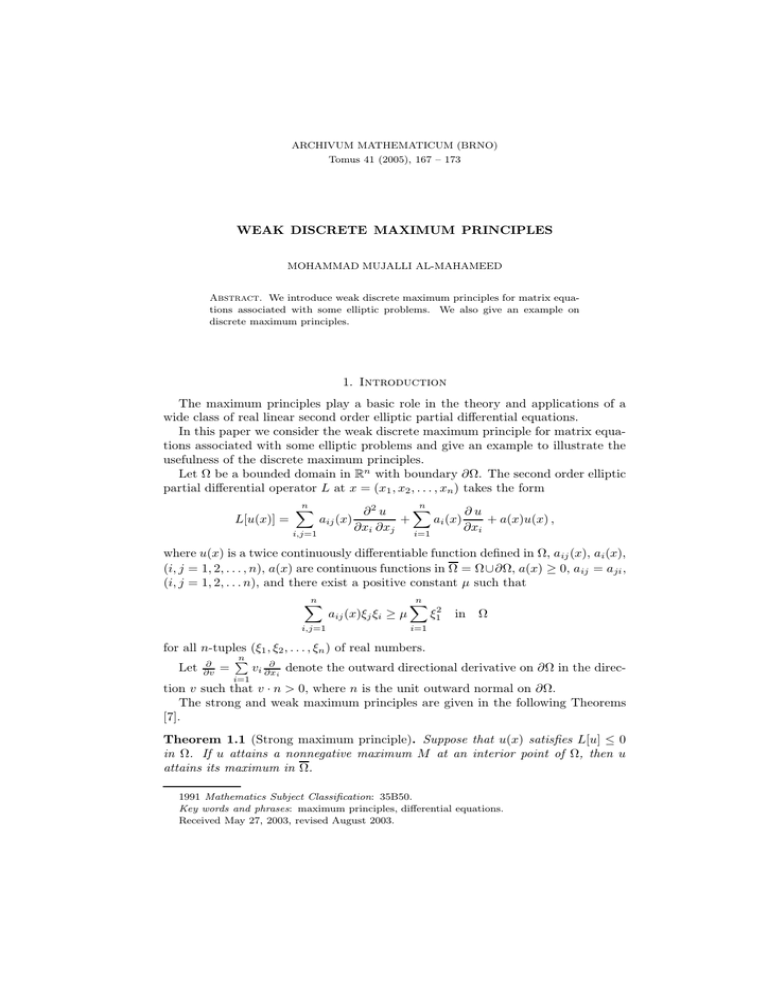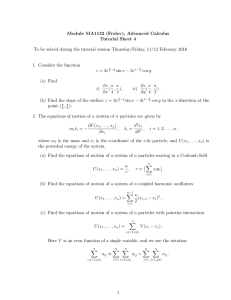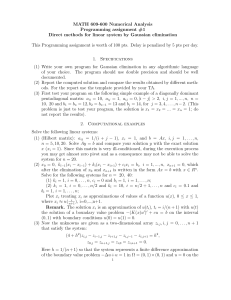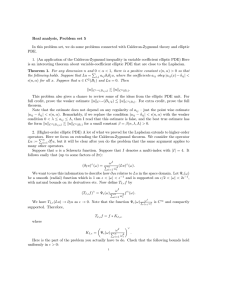WEAK DISCRETE MAXIMUM PRINCIPLES
advertisement

ARCHIVUM MATHEMATICUM (BRNO)
Tomus 41 (2005), 167 – 173
WEAK DISCRETE MAXIMUM PRINCIPLES
MOHAMMAD MUJALLI AL-MAHAMEED
Abstract. We introduce weak discrete maximum principles for matrix equations associated with some elliptic problems. We also give an example on
discrete maximum principles.
1. Introduction
The maximum principles play a basic role in the theory and applications of a
wide class of real linear second order elliptic partial differential equations.
In this paper we consider the weak discrete maximum principle for matrix equations associated with some elliptic problems and give an example to illustrate the
usefulness of the discrete maximum principles.
Let Ω be a bounded domain in Rn with boundary ∂Ω. The second order elliptic
partial differential operator L at x = (x1 , x2 , . . . , xn ) takes the form
L[u(x)] =
n
X
n
aij (x)
i,j=1
X
∂u
∂2 u
+
ai (x)
+ a(x)u(x) ,
∂xi ∂xj
∂x
i
i=1
where u(x) is a twice continuously differentiable function defined in Ω, aij (x), ai (x),
(i, j = 1, 2, . . . , n), a(x) are continuous functions in Ω = Ω∪∂Ω, a(x) ≥ 0, aij = aji ,
(i, j = 1, 2, . . . n), and there exist a positive constant µ such that
n
X
i,j=1
aij (x)ξj ξi ≥ µ
n
X
ξ12
in Ω
i=1
for all n-tuples (ξ1 , ξ2 , . . . , ξn ) of real numbers.
n
P
∂
∂
Let ∂v
=
denote the outward directional derivative on ∂Ω in the direcvi ∂x
i
i=1
tion v such that v · n > 0, where n is the unit outward normal on ∂Ω.
The strong and weak maximum principles are given in the following Theorems
[7].
Theorem 1.1 (Strong maximum principle). Suppose that u(x) satisfies L[u] ≤ 0
in Ω. If u attains a nonnegative maximum M at an interior point of Ω, then u
attains its maximum in Ω.
1991 Mathematics Subject Classification: 35B50.
Key words and phrases: maximum principles, differential equations.
Received May 27, 2003, revised August 2003.
168
M. M. AL-MAHAMEED
Theorem 1.2 (Weak maximum principle). Suppose that u(x) satisfies L[u] ≤ 0 in
Ω, then max u(x) ≤ max{0, max u(x)}.
x∈Ω
x∈∂Ω
Theorem 1.3. Let u(x) satisfy L[u] ≤ 0 in Ω. Suppose that u attains a nonnegative
maximum M at a boundary point P . If P lies on the boundary of a ball in Ω, then
∂u
∂y > 0 at P , unless u = M in Ω.
Remark 1.1. The condition that P lies on the boundary of a ball in Ω in Theorem
1.3 is called the interior sphere property at P of ∂Ω. If this property is not satisfied,
the conclusion of Theorem 1.3 will in general not be valid.
Let us first present some matrix notations.
Given a matrix A = (aij ), i, j = 1, 2, . . . , n, we say that A is reducible if there
exist a permutation matrix B such that
A11 A12
t
,
BAB =
0
A22
where B t denotes the transpose of B, A11 is an r × r submatrix, and A22 is an
(n − r) × (n − r) submatrix with r ∈ {1, 2, . . . , n − 1}.
If no such permutation matrix exists, then A is irreducible. We say that A is
diagonally dominant if
X
|aij |
i = 1, 2, . . . , n .
|aii | ≥
j=1
j6=1
Furthermore, A is irreducibly diagonally dominant if it is irreducible, diagonally
dominant, and
X
|ai0 i0 | >
|ai0 j |
j=1
j6=i0
holds for some i0 ∈ {1, 2, . . . , n}.
Consider the discrete approximation to the boundary value problem
(1.1)
L u(x) = f (x) in Ω ,
(1.2)
β u(x) = g(x) on ∂Ω .
Here β is the boundary operator, for example
∂u
β u(x) = α1 (x)
+ α2 (x) u .
∂n
By Pi , i = 1, 2, . . . , n (or Pi , i = n + 1, . . . , n + m) we denote the nodal points
which belong to Ω (or ∂Ω). The finite difference method or the finite element
method with mesh h size leads to the following equations which approximate (1.1),
WEAK DISCRETE MAXIMUM PRINCIPLES
169
(1.2).
(1.3)
n
X
aij wj +
j=1
(1.4)
n
X
n+m
X
aij wj = fi ,
i = 1, 2, . . . , n ,
aij wj = gi ,
i = n + 1, . . . , n + m .
j=n+1
aij wj +
j=1
n+m
X
j=n+1
Here (w1 , w2 , . . . , wn+m ), (f1 , f2 , . . . , fn ), (gn+1 , gn+2 , . . . , gn+m), are approximate
values of u(P1 ), u(P2 ), . . . , u(Pn+m ) , f (P1 ), f (P2 ), . . . , f (Pn ) , g(Pn+1 ), u(Pn+2 ),
. . . , g(Pn+m ) , respectively.
The matrices (aij ), i = 1, 2, . . . , n, j = 1, 2, . . . , n + m, and (aij ), i = n +
1, . . . , n + m, j = 1, 2, . . . , n + m, are the approximations to the operators L and β,
respectively.
Now define sets as follows:
Dn = {1, 2, . . . , n} ,
Fi,m = {j, j = n + 1, . . . , n + m, aij 6= 0} ,
Gm =
n
[
i = 1, 2, . . . , n .
Fi,m ,
i=1
Hm = {n + 1, n + 2, . . . , n + m}\Gm .
A strong discrete maximum principle for (1.3), (1.4) is given in the following
Theorem [6].
Theorem 1.4. Assume that aii > 0, aij ≤ 0, i 6= j, i = 1, 2, . . . , n, j = 1, 2, . . . , n+
m.
n+m
X
aij > 0 ,
i = 1, 2, . . . , n ,
j=1
and that A = (aij ), i, j, = 1, 2, . . . , n, is irreducibly diagonally dominant. Let
(w1 , w2 , . . . , wn+m ) satisfy
n+m
X
aij wj ≤ 0 ,
i = 1, 2, . . . , n .
j=1
If there exist some r ∈ {1, 2, . . . , n} such that
max
j=1,2,...,n+m
wj = w r ≥ 0 ,
then
wj = w r ,
wj ≤ w r ,
j ∈ Dn ∪ Gm ,
j ∈ Hm .
170
M. M. AL-MAHAMEED
2. The weak discrete maximum principle
In this section we introduce the weak discrete maximum principle for (1.3), (1.4).
Theorem 2.1 (Weak discrete maximum principle [1]). Assume that aii > 0, aij ≤
0, i 6= j, i = 1, 2, . . . , n, j = 1, 2, . . . , n + m.
n+m
X
aij > 0 ,
i = 1, 2, . . . , n ,
j=1
and that A = (aij ), i, j = 1, 2, . . . , n, is irreducibly diagonally dominant. Let
(w1 , w2 , . . . , wn+m ) satisfy
n+m
X
aij wj ≤ 0 ,
i = 1, 2, . . . , n .
j=1
Then,
max
1≤i≤n+m
n
wi ≤ max 0,
max
n+1≤j≤n+m
o
.
Theorem 2.2. Assume that aii > 0, aij ≤ 0, i 6= j, i = 1, 2, . . . , n, j = 1, 2, . . . , n+
m,
n+m
X
aij ≥ 0 ,
i = 1, 2, . . . , n + m ,
j=1
and that A = (aij ), i, j = 1, 2, . . . , n is irreducibly diagonally dominant. Let
(w1 , w2 , . . . , wn+m ) satisfy
n+m
X
aij wj ≤ 0 ,
i = 1, 2, . . . , n .
j=1
If there exist some r(n + 1 ≤ r ≤ n + m) and at least one q (1 ≤ q ≤ n) such that
(
)
max 0,
n+m
X
arj ≥ 0 ,
max
1≤j≤n+m
j 6= r ,
wj
= wr ≥ 0 ,
j = 1, 2, . . . , n + m ,
j=1
then
n+m
X
arj wj > 0
j=1
unless
wj = w r ,
j ∈ Dn ∪ Gm ,
wj 6= wr ,
j ∈ Hm .
arq ≤ 0 ,
WEAK DISCRETE MAXIMUM PRINCIPLES
171
Proof. Assume that
n+m
X
arj wj ≤ 0 .
j=1
Then we have
0≥
n+m
X
arj wj = arr wr +
j=1
≥
"
−
arj wj
j=1
j6=r
n+m
X
#
arj wr +
j=1
j6=r
=−
n+m
X
n+m
X
n+m
X
arj wj
j=1
j6=r
arj (wr − wj )
j=1
j6=r
= −arq (wr − wq ) −
n+m
X
arj (wr − wj ) ≥ 0 .
j=1
j6=r
j6=q
From the fact arq < 0, it follows that
wq = w r +
max
1≤j≤n+m
wj ≥ 0 .
Since 1 ≤ q ≤ n, an application of Theorem 1.4 leads to
(2.1)
w j = wq = wr
j ∈ Dn ∪ Gm .
On the other hand, it is clear that
(2.2)
w j ≤ wq = wr ,
j ∈ Hm .
Hence, (2.1), (2.2) contradicts the hypotheses in Theorem 2.2. Thus, we have
n+m
X
arj wj ≤ 0 .
j=1
This completes the proof.
3. Example
In this section we give an example to illustrate the discrete maximum principles.
Consider the domain Ω ⊂ R2 with boundary ∂Ω, P1 , P2 denote the interior points
of Ω and P3 − −P12 denote the boundary points shown in Figure 1 with a uniform
mesh (h = 1, n = 2, m = 10).
−∆u + u = −5
u = −9
in Ω ,
on ∂Ω .
172
M. M. AL-MAHAMEED
Fig. 1: Uniform mesh of the domain (h = 1, n = 2, m = 10):
(a) domain direction (b) finite difference (c) finite element.
The finite difference method with mesh points in Figure 1 (b) leads to
5 −1 . . . 0 −1
0 0 −1
0 0 −1
0 0
−1
5 ... 0
0 −1 0
0 −1 0
0 −1 0
−8
−8
. . .
−9
−9
−9
−9 = −5
−5
−9
−9
−9
−9
−9
−9
×
In this case Dn = {1, 2}, Gm = {4, 5, 7, 8, 10, 11}, Hm = {3, 6, 9, 12}. Since
max wj = w1 = w2 = −8, the assumptions of Theorem 1.4 do not hold, but
1≤j≤12
those of Theorem 2.1 hold.
WEAK DISCRETE MAXIMUM PRINCIPLES
173
4. Concluding remarks
If A = (aij ), i, j = 1, 2, . . . , n, is a matrix satisfying all conditions of Theorem
1.4, then A−1 > 0.
In view of applications to numerical analysis, the discrete maximum principle is
useful in the resulting matrix equations, which approximate elliptic boundary value
problems by employing the finite difference method or the finite element method.
The weak discrete maximum principle is the discrete counterpart of Theorem 1.2
and well established in [2]. Moreover, this is applied not only to linear boundary
value problems, but also to nonlinear boundary value problem [4], [5].
In the discrete matrix equations associated with the elliptic boundary value
problems, it is desirable to reduce the number of the boundary points belonging
to Hm as much as possible, in order to obtain good numerical solutions from the
viewpoint of the maximum principle [2].
References
[1] Ciarlet, P. G., Discrete maximum principles for finite difference operators, Aequationes Math.
4 (1970), 336–352.
[2] Ciarlet, P. G. and Raviart, P. A., Maximum principle and uniform convergence for the finite
element method, Comput. Methods Appl. Mech. Engrg. 2 (1973), 17–31.
[3] Gilbarg, D. and Trudinger, N. S., Elliptic partial differential equations of second order,
Springer, New York, 1983.
[4] Ishihara, K., On finite element schemes of the Dirichlet problem for a system of nonlinear
elliptic equations, Numer. Funct. Anal. Optim. 3 (1981), 105–136.
[5] Ishihara, K., Finite element approximations applied to the nonlinear boundary value problem
∆u = bu2 , Publ. Res. Inst. Math. Sci. 18 (1982), 17–34.
[6] Al-Mahameed, M. M., A discrete maximum principle, Far East J. Appl. Math. 5 (3) (2001),
309–315.
[7] Greenspan, D., Introductory numerical analysis of elliptic boundary value problems, Harper
and Row, New York (1965).
Department of Mathematics, Irbid National University
P. O. Box 2600, Irbid, Jordan
E-mail: al mahameed200@yahoo.com
![1. Let R = C[x].](http://s2.studylib.net/store/data/010491179_1-9a9c70e395518f466f652079f02ae14a-300x300.png)






